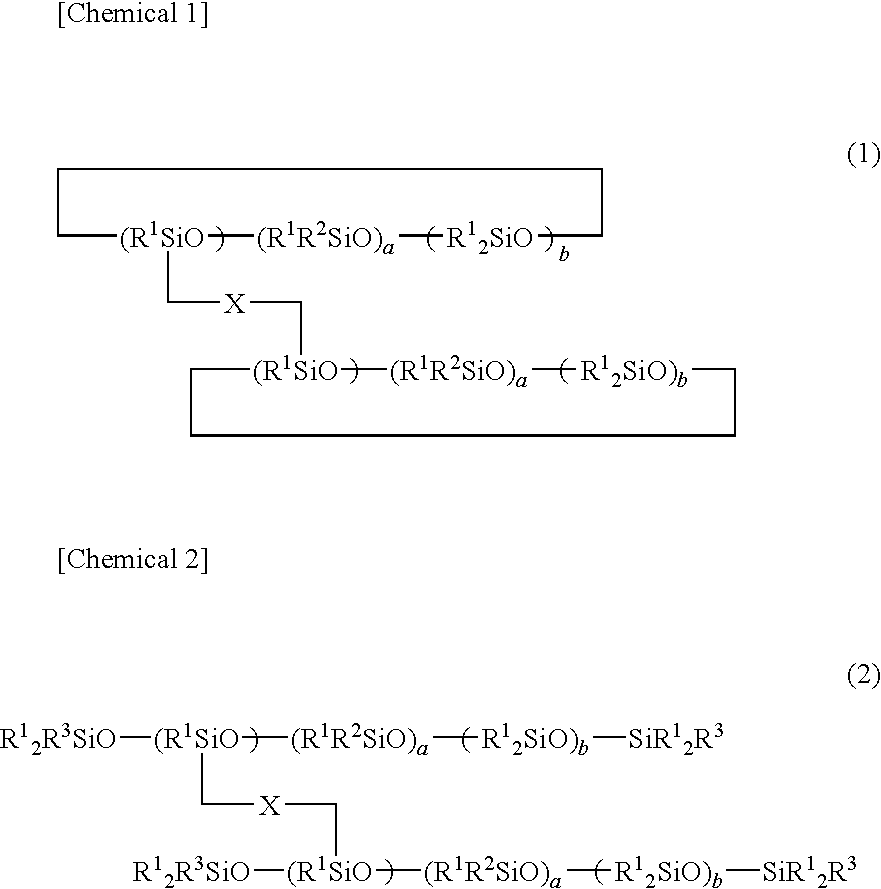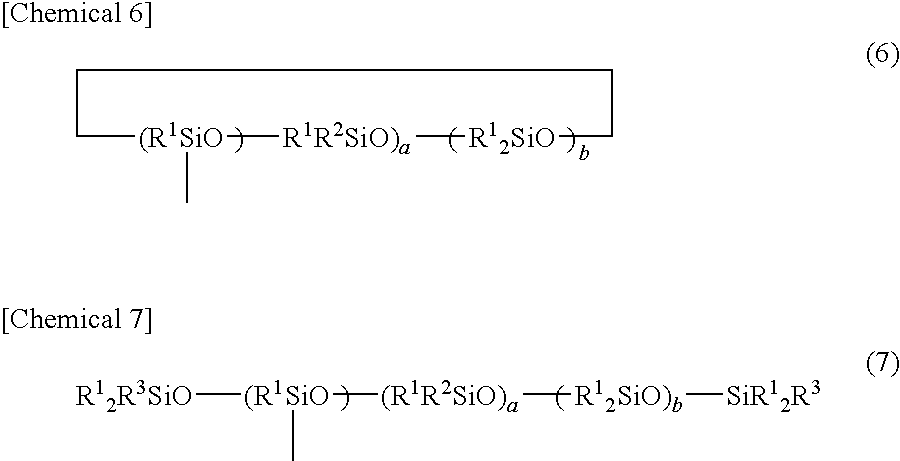Thermosetting resin composition and semiconductor sealing medium
a technology of resin composition and sealing medium, which is applied in the direction of semiconductor devices, semiconductor/solid-state device details, solid-state devices, etc., can solve the problems of difficult to obtain sufficient properties in compositions, and achieve the effects of reducing the viscosity of resin composition, reducing the number of cured materials, and improving the adhesion of the cured material
- Summary
- Abstract
- Description
- Claims
- Application Information
AI Technical Summary
Benefits of technology
Problems solved by technology
Method used
Image
Examples
synthesis example 1
[0152]Dioxane (120 parts), 1,3,5,7-tetramethylcyclotetrasiloxane (60 parts, SiH: 1 mole), and 2% toluene solution (0.6 part) of platinum catalyst were added to a four-necked flask with an agitator, thermometer, reflux condenser, and drop funnel attached thereto, and heated to 60° C., and then, a 33% dioxane solution (267 parts) of polydimethylsiloxane terminated with vinyldimethylsiloxane (88 parts, vinyl group: 0.25 mole) with a molecular weight of 704 represented by following average composition formula (I) was dropped into the flask for 2 hours. After dropping the solution, the resultant was slowly heated, and further stirred at 80° C. for 3 hours.
CH2═CH-(Me2SiO)8—Si(Me)2-CH═CH2 (I)
[0153]Then, 33% dioxane solution (288 parts) of 4-vinylcyclohexeneoxide (93 parts, 0.75 mole) was dropped for 2 hours. Further, the resultant was reacted at 80° C. for 5 hours, and it was confirmed that SiH disappeared by FT-IR. After that, the resultant was subjected to activated carbon treatment to ...
synthesis example 2
[0155]Dioxane (200 parts), hydrosiloxane (100 parts, SiH: 1 mole) with a molecular weight of 402 represented by following average composition formula (II), and 2% toluene solution (0.6 part) of platinum catalyst were added to a four-necked flask with an agitator, thermometer, reflux condenser, and drop funnel attached thereto, and heated to 80° C., and then, 4-vinylcyclohexeneoxide (93 parts, 0.75 mole) was dropped for 2 hours. After dropping, the resultant was slowly heated, and further stirred at 80° C. for 3 hours. Then, a 33% dioxane solution (267 parts) of polydimethylsiloxane terminated with vinyldimethylsiloxane (88 parts, vinyl group: 0.25 mole) with a molecular weight of 704 represented by following average composition formula (III) was dropped for 2 hours. Further, the resultant was reacted at 80° C. for 5 hours, and it was confirmed that SiH disappeared by FT-IR. After that, the resultant was subjected to activated carbon treatment to remove volatile constituents, and sam...
synthesis example 3
[0157]Toluene (300 parts), dimethylpolysiloxane with OH groups at both terminals (95 parts, OH group: 0.25 mole) with a molecular weight of 758 represented by following average composition formula (IV), and 1,3,5,7-tetramethylcyclotetrasiloxane (60 parts, SiH group: 1 mole) were placed in a four-necked flask with an agitator, thermometer, reflux condenser, and drop funnel attached thereto.
HO(Me2SiO)10H (IV)
[0158]A 2% toluene solution (1.2 part) of platinum catalyst was added to the flask, and the resultant was refluxed at 117° C. for 3 hours. After cooling to 80° C., 280 parts of 33% toluene solution of 4-vinylcyclohexeneoxide (93 parts) was dropped for 2 hours. After dropping the solution, the resultant was further reacted at 80° C. for 5 hours, and it was confirmed that SiH disappeared by FT-IR. After that, the resultant was subjected to activated carbon treatment to remove volatile constituents, and sample 3 (230 parts) was obtained.
[0159]The epoxy value of sample 3 was 0.300 (e...
PUM
| Property | Measurement | Unit |
|---|---|---|
| particle diameter | aaaaa | aaaaa |
| carbon number | aaaaa | aaaaa |
| temperatures | aaaaa | aaaaa |
Abstract
Description
Claims
Application Information
 Login to View More
Login to View More - R&D
- Intellectual Property
- Life Sciences
- Materials
- Tech Scout
- Unparalleled Data Quality
- Higher Quality Content
- 60% Fewer Hallucinations
Browse by: Latest US Patents, China's latest patents, Technical Efficacy Thesaurus, Application Domain, Technology Topic, Popular Technical Reports.
© 2025 PatSnap. All rights reserved.Legal|Privacy policy|Modern Slavery Act Transparency Statement|Sitemap|About US| Contact US: help@patsnap.com



